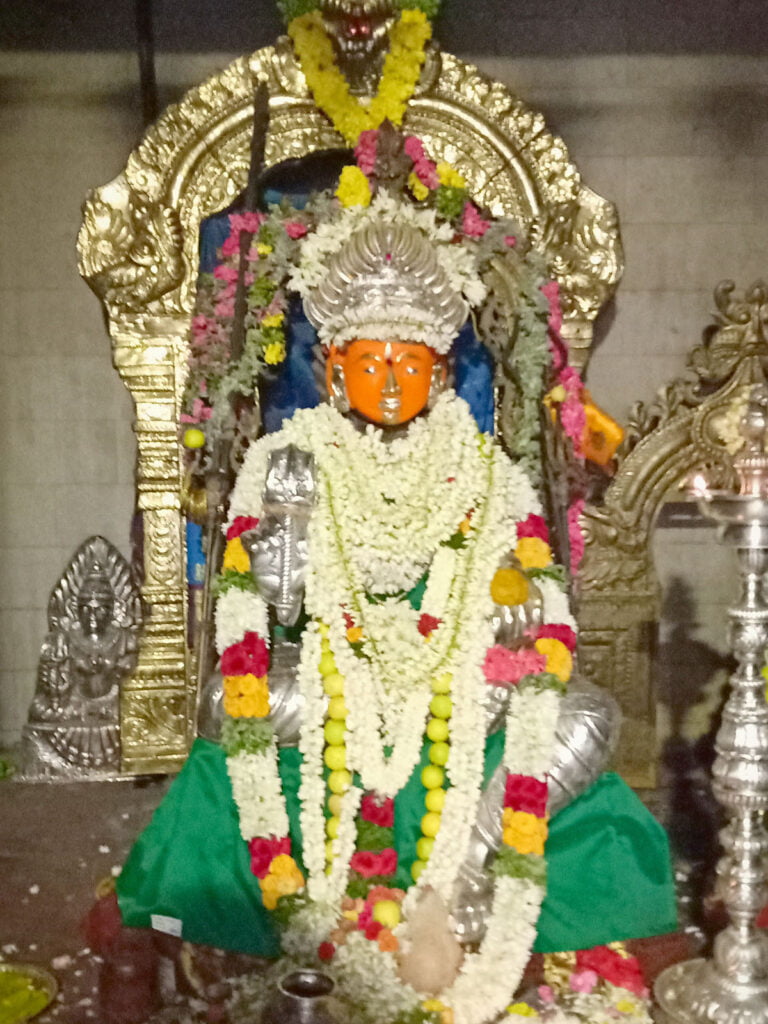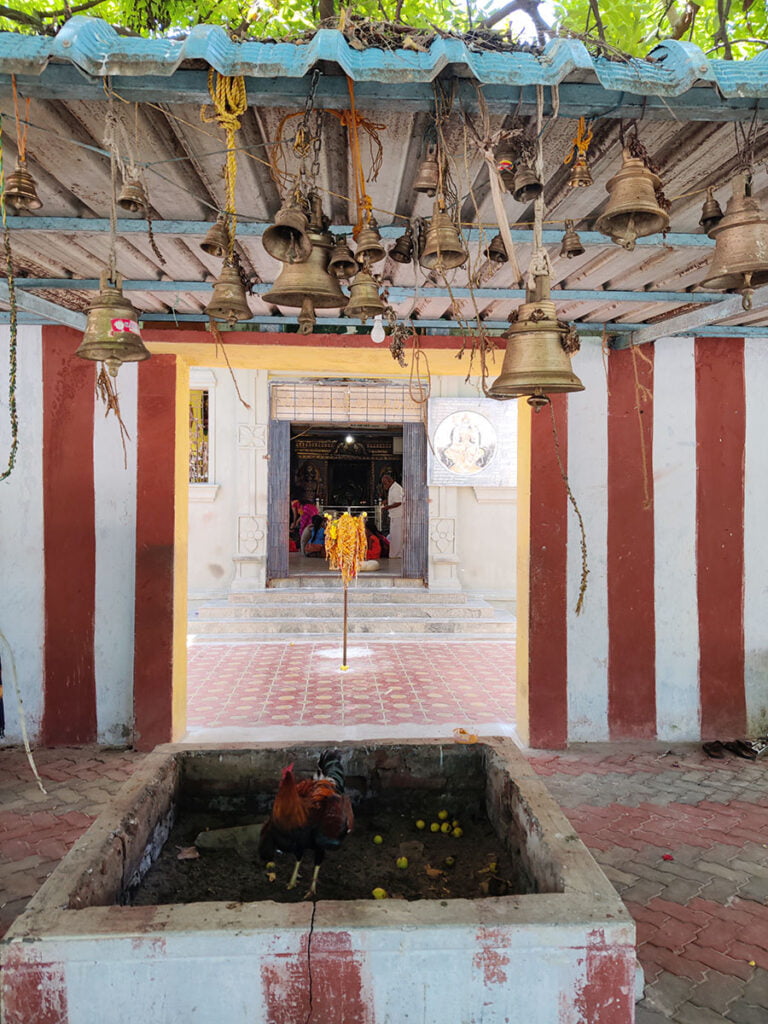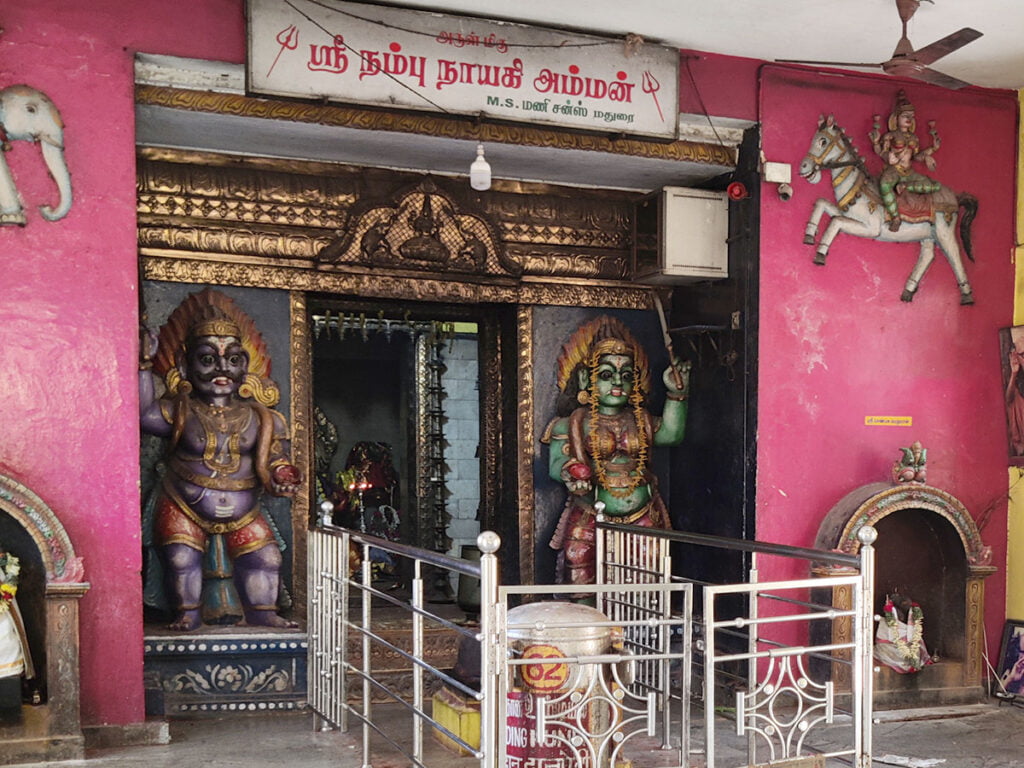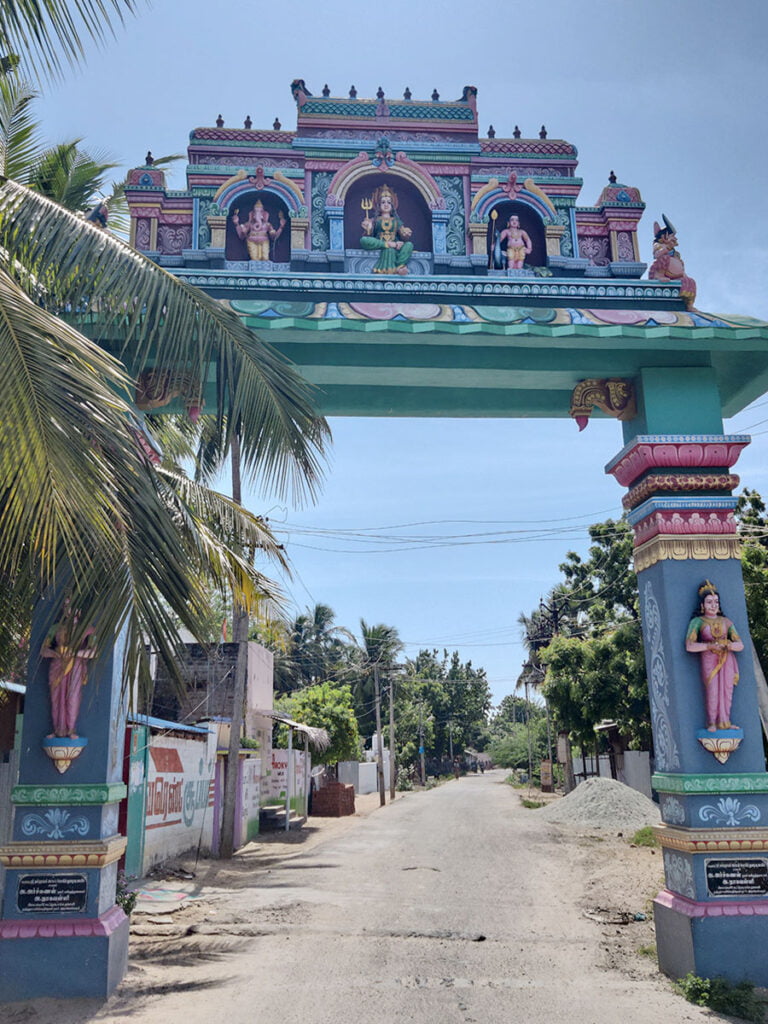Nambunayaki Amman Temple Rameswaram
The Nambunayaki Amman Temple is a Hindu temple dedicated to Goddess Nambunayaki, situated in Dhanushkodi, Rameswaram, Tamil Nadu, India. It is a significant temple for the local community, particularly the Maratha Brahmin families, who consider Nambunayaki their Kula Deivam (family deity).

Contents
- 1 Nambunayaki Amman Temple History:
- 2 Significance of Nambunayaki Amman Temple:
- 3 Specialty of Nambunayaki Amman Temple:
- 4 Nambunayaki Amman Temple Festivals:
- 5 Places to visit near Nambunayaki Amman Temple:
- 6 FAQ:
- 6.0.1 Q: Where is the Nambunayaki Amman Temple located?
- 6.0.2 Q: When was the temple built?
- 6.0.3 Q: Who is Nambunayaki Amman?
- 6.0.4 Q: What is the significance of the temple?
- 6.0.5 Q: What are the temple timings?
- 6.0.6 Q: What are some of the special pujas and festivals celebrated at the temple?
- 6.0.7 Q: Are there any interesting legends associated with the temple?
- 6.0.8 Q: How can I reach the temple?
- 6.0.9 Q: What are some of the offerings made to Nambunayaki Amman?
- 6.0.10 Q: What are some of the things to do near the Nambunayaki Amman Temple?
- 6.0.11 Q: Is there anything else I should know before visiting the Nambunayaki Amman Temple?
- 7 How to reach Nambunayaki Amman Temple:
- 8 Google Maps:
Nambunayaki Amman Temple History:
The temple’s exact origins are shrouded in legend, but two popular stories exist:
- The Two Sages: The first legend tells of two sages, Dakshina Duruvan and Pachima Duruvan, who performed intense penance near the temple site. Pleased by their devotion, Goddess Parvadhavardini appeared before them in the form of Dakshina Kal and blessed them. The sages then remained at the site, treating those suffering from illnesses. It is believed that the spirits of these sages continue to assist those who seek the goddess’s healing powers.
- The Sinhalese King: The second legend relates to a Sinhalese king named Sulodharan who fell ill. He traveled to the temple, seeking Nambunayaki Amman’s grace. With unwavering faith, he built a hut near the temple and diligently prayed, bathing in the holy theertham (temple tank). The goddess cured him, prompting the king to build a temple in her honor and provide facilities for others seeking healing. This legend gave rise to the popular saying in Rameswaram, “Nambunayakiyai Vananginal Vambu illai,” meaning “There will be no suffering if you worship Nambu.”
While the temple’s precise age is unknown, it is believed to have existed for centuries. The current structure dates back to the 14th century, showcasing Dravidian architectural style. The temple features a gopuram (gateway tower) adorned with intricate carvings and a sanctum sanctorum housing the idol of Nambunayaki Amman.
The goddess is depicted in a seated position, holding a lotus flower in one hand and a trishul (trident) in the other. Devotees visit the temple throughout the year, seeking blessings for healing, prosperity, and protection. Special pujas (rituals) are performed during festivals like Navaratri and Thai Pongal.
Read More>> Why do we Ring Bells in Hindu Temples?

Significance of Nambunayaki Amman Temple:
Religious Significance:
- Goddess of Protection: Nambunayaki Amman is revered as the protector facing the south direction. Devotees seek her blessings for overall well-being, particularly protection from evil forces and negative energies.
- Fulfilling Wishes: The temple is known for granting wishes, especially the desire for children. A unique ritual involves devotees tying cradles with baby dolls to the temple tree, promising to name their child “Nambu” if their wish is fulfilled. This practice has led to the prevalence of the name “Nambu” in Rameshwaram.
- Healing Powers: The temple complex houses multiple holy springs (“theerthams”) believed to possess medicinal properties. Devotees bathe in these springs seeking relief from various ailments.
Historical Significance:
- Ancient Origins: While the exact date of construction remains unclear, the temple’s origins are believed to date back centuries.
- Dhanushkodi Cyclone: The original temple stood in Dhanushkodi, a now-abandoned town swallowed by the sea during the devastating 1964 cyclone. The idol of Nambunayaki Amman was miraculously recovered and shifted to its current location, adding to the temple’s mystique.
Cultural Significance:
- Family Deity: Nambunayaki Amman is the Kula Deivam (family deity) for many Maratha Brahmin families in the region. They hold special reverence for the temple and often name their children after the goddess.
- Local Traditions: The temple is a vibrant hub of local customs and traditions. Devotees perform various rituals and offerings, seeking the goddess’s blessings.
Read More>> Thirunallar Temple of Sri Darbaranyeswara Swamy

Specialty of Nambunayaki Amman Temple:
- Goddess of Protection: Nambunayaki Amman is considered the protecting goddess of the south direction. Devotees seeking blessings for protection often visit this temple.
- Blessing Childless Couples: A popular belief is that praying to Nambunayaki Amman can bless childless couples with children. Devotees tie small cradles with baby dolls to the banyan tree near the temple as a form of offering.
- Medicinal Properties: The holy springs surrounding the temple are believed to have medicinal properties and are revered as Sarvaroga Nivarana Theerthams (meaning “springs curing all diseases”).
- Family Deity: Nambunayaki Amman is the family deity (Kula Deivam) of many Maratha Brahmin families in the region. Many families in Rameswaram even have the name “Nambu” incorporated into their names.
- Unique Location: The temple is situated on a sand dune near the sea, surrounded by banyan trees. This adds to its serene and mystical atmosphere.
Read More>> Murudeshwar Temple Karnataka: India’s 2nd Massive Shiva Statue

Nambunayaki Amman Temple Festivals:
The most celebrated festival at the Nambunayaki Amman Temple is the Navarathri. It falls in the Tamil months of Purattasi (September-October) and is a nine-day festival honoring the nine forms of the Durga Mata.
- Day 1: The festival begins with the invocation of Goddess Durga. Special pujas and abhishekams are performed on the deity.
- Days 2-8: Each day is dedicated to a specific form of Durga, such as Shailaputri, Brahmacharini, Chandraghanta, Kushmanda, Skanda Mata, Katyayani, Kalaratri, and Maha Gauri. The deity is adorned with special alankaras (ornaments) and pujas are performed according to the specific form being worshipped.
- Day 9: This day is called Vijayadashami or Dusshera, and it marks the victory of good over evil. A grand procession is held with the idol of Goddess Durga, culminating in the immersion of the idol in the sea.
Other festivals celebrated at the Nambunayaki Amman Temple include:
- Thai Poosam: This festival falls in the Tamil month of Thai (January-February) and celebrates the birth of Lord Murugan.
- Panguni Uthiram: This festival falls in the Tamil month of Panguni (March-April) and celebrates the marriage of Lord Shiva and Parvati.
Read More>> 3000yr Old Poombarai Murugan Temple

Places to visit near Nambunayaki Amman Temple:
- Ramanathaswamy Temple: This is one of the most famous temples in Rameswaram and is known for its impressive architecture and religious significance.
- Dhanushkodi: A ghost town near Rameswaram, Dhanushkodi offers a unique and tranquil atmosphere. It is located at the confluence of the Bay of Bengal and the Indian Ocean.
- Agni Teertham: This is a sacred bathing spot in Rameswaram and is believed to be one of the 64 sacred baths in India. Pilgrims take a dip in the sea before entering the Ramanathaswamy Temple.
- Gandamadana Parvatham: It is a small hillock with a two-storied Mandapam (hall) where you can get panoramic views of Rameswaram.
- Pamban Bridge: If you enjoy engineering marvels, the Pamban Bridge is a must-visit. It is a railway bridge that connects Rameswaram to the mainland and offers stunning views.
- A.P.J. Abdul Kalam Memorial: Visit the memorial of Dr. A.P.J. Abdul Kalam, the former President of India, who was born in Rameswaram.
- Adam’s Bridge (Rama Setu): According to Hindu mythology, this is the bridge built by Lord Rama’s army of monkeys and bears to rescue his wife Sita from the demon king Ravana.
- Kothandaramaswamy Temple: Situated on the way to Dhanushkodi, this temple is believed to be the spot where Lord Rama crowned Vibhishana as the king of Lanka.
FAQ:
Q: Where is the Nambunayaki Amman Temple located?
The Nambunayaki Amman Temple is located in Dhanushkodi, a town on the easternmost tip of Rameswaram Island in Tamil Nadu, India.
Q: When was the temple built?
The exact date of the temple’s construction is unknown, but it is believed to be over 500 years old. Some legends claim it could be even older.
Q: Who is Nambunayaki Amman?
Nambunayaki Amman is a manifestation of Parvati, the Hindu goddess of power and destruction. She is also known as Thazhaikkattamman (meaning “Goddess of the Palmyra Forest”) and Thangammal (meaning “Golden Mother”).
Q: What is the significance of the temple?
The Nambunayaki Amman Temple is a popular pilgrimage site for Hindus, especially those seeking blessings for fertility, marriage, and good health. It is also considered the Kula Deivam (family deity) of many Maratha Brahmin families in the region.
Q: What are the temple timings?
The temple is open from 6:00 AM to 11:00 AM and from 4:30 PM to 8:30 PM.
Q: What are some of the special pujas and festivals celebrated at the temple?
- Navaratri: During the nine-day Navaratri festival, nine forms of Nambunayaki Amman are worshipped daily.
- Sivaratri: A special puja is performed on Sivaratri, a night dedicated to Lord Shiva.
- Fire Walking Festival: A unique fire-walking festival takes place in April, where devotees walk barefoot on burning coals as an act of devotion.
Q: Are there any interesting legends associated with the temple?
- One legend tells the story of how Nambunayaki Amman appeared to two sages meditating in the forest.
- Another legend claims that the name “Nambu” became popular in the region because of the blessings of Nambunayaki Amman for couples seeking children.
Q: How can I reach the temple?
The Nambunayaki Amman Temple is about 2 km from the Ramanathaswamy Temple in Rameswaram. You can reach the temple by auto rickshaw, taxi, or private vehicle.
Q: What are some of the offerings made to Nambunayaki Amman?
Devotees typically offer flowers, fruits, coconuts, and turmeric to the Goddess. Some may also offer milk, ghee, or honey.
Q: What are some of the things to do near the Nambunayaki Amman Temple?
After visiting the temple, you can explore the town of Dhanushkodi, which is known for its beautiful beaches and its proximity to Adam’s Bridge. You can also visit the nearby Ramanathaswamy Temple, one of the 12 Jyotirlinga shrines in India.
Q: Is there anything else I should know before visiting the Nambunayaki Amman Temple?
Dress modestly when visiting the temple. Men should remove their shirts and dhotis, and women should wear sarees or salwar kameez. It is also customary to remove your footwear before entering the temple.
How to reach Nambunayaki Amman Temple:
By Air: The nearest airport is Madurai International Airport (IXM), and from there, you can hire a taxi or use other local transportation to reach Rameswaram.
By Train: Rameswaram has its own railway station, Rameswaram Railway Station (RMM), which is well-connected to major cities in India. From the railway station, you can hire an auto-rickshaw or taxi to reach the temple.
By Road: Rameswaram is well-connected by road. You can take a bus or hire a taxi from nearby cities. If you’re driving, you can use maps to navigate to Rameswaram.
Local Transportation: Once you reach Rameswaram, you can use auto-rickshaws, cycle rickshaws, or taxis to travel within the town. The Ramanathaswamy Temple is a prominent landmark and should be easy to find.

One Comment